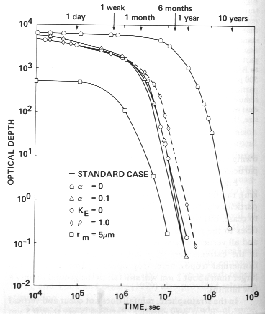Prolonged Darkness

According to Alvarez (1980), the bolide that struck the earth 65
million years ago was approximately 10 ± 4 km in diameter
with 6,000 to 60,000 tonnes of matter being dispersed into the
atmosphere. This debris would have stayed in the
stratosphere for several years and be distributed world wide.
(Alvarez, 1980)
As you can see even Alvarez was unable to depict accurately
how long the debris would have remained in the atmosphere.
It wasn't until 1982 when a group of scientists led by O.B.
Toon answered this question. Using aerosol physics and
computer simulations, the group was able to make the following
conclusions: Large quantities of debris would have remained in
the atmosphere for 3 to 6 months; the debris would have
caused a loss of vision for 1 to 6 months and photosynthesis for 2 months to 1 year.
These calculations took into account several different variables such as:
coagulation (particles colliding and precipitating out of the atmosphere), initial altitude,
particle size, rain out rate, particle density, and rate at which the debris spreads from the impact
site.

A graph showing the different lengths of darkness with different varibles used.

| 
|
Back to Main Page
| Go To Temperature Change
|




